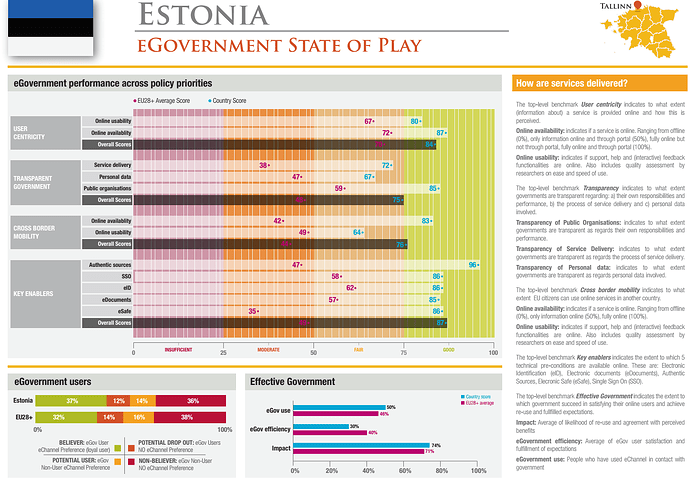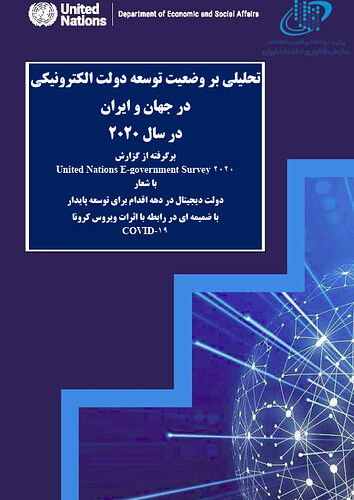پیمایش دولت الکترونیک سازمان ملل:
[center]
UN E-Government Survey 2018
واکنش وزیر ارتباطات دولت دوازدهم به تغییر رتبه ایران در این شاخص:
[center]
دور چهارم ارزیابی وضعیت دولت الکترونیک در ایران:
https://ito.gov.ir/web/guest/news/-/view//2154
گزارش چهارم دولت الکترونیکی.pdf (6.5 مگابایت)
Networked Readiness Index
Since 2001, The Global Information Technology Report series published by the World Economic Forum in partnership with INSEAD and Cornell University has measured the drivers of the ICT revolution globally, using the Networked Readiness Index (NRI). The Index has evolved over time and currently assesses the state of networked readiness using 53 individual indicators. For each of the 139 economies covered, it allows the identification of areas of priority to more fully leverage ICTs for socioeconomic development.
The networked readiness framework
The networked readiness framework rests on six principles: (1) a high-quality regulatory and business environment is critical in order to fully leverage ICTs and generate impact; (2) ICT readiness—as measured by ICT affordability, skills, and infrastructure—is a pre-condition to generating impact; (3) fully leveraging ICTs requires a society-wide effort: the government, the business sector, and the population at large each have a critical role to play; (4) ICT use should not be an end in itself. The impact that ICTs actually have on the economy and society is what ultimately matters; (5) the set of drivers—the environment, readiness, and usage—interact, co-evolve, and reinforce each other to form a virtuous cycle; and (6) the networked readiness framework should provide clear policy guidance.
The framework translates into the NRI, a composite indicator made up of four main categories (subindexes), 10 subcategories (pillars), and 53 individual indicators distributed across the different pillars:
A. Environment subindex
- Political and regulatory environment (9 indicators)
- Business and innovation environment (9 indicators)
B. Readiness subindex
- Infrastructure (4 indicators)
- Affordability (3 indicators)
- Skills (4 indicators)
C. Usage subindex
- Individual usage (7 indicators)
- Business usage (6 indicators)
- Government usage (3 indicators)
D. Impact subindex
- Economic impacts (4 indicators)
- Social impacts (4 indicators)
http://reports.weforum.org/global-information-technology-report-2016/networked-readiness-index/
European Commision The Digital Economy and Society Index (DESI)
EU eGovernment Report
Performance is measured as an average of scores for 4 top level benchmarks: user centricity, transparency, cross-border mobility, key enablers.
Top-level benchmarks for e-government
User Centricity: Governments have advanced in making public services digital, but focussed less on the quality of the delivery from the user’s perspective, especially in terms of ease and speed of use.
Transparency: The Transparency indicator examines the extent to which governments are transparent about their own responsibilities and performance, the service delivery process, and the personal data involved.
Cross Border Mobility: eGovernment services are still lacking the adequate level of support to citizens and business who wish to move or operate across borders. This is undesirable since this can help accelerate the realization of an inclusive Digital Single Market. Business-related services are more advanced in terms of cross-border mobility than citizen-related services
Key Enablers: This indicator measures the availability of five technical elements which are essential for public services: Electronic Identification (eID), Electronic documents (eDocuments), Authentic Sources, Electronic Safe (eSafe), Single Sign On (SSO)
eGovernmentBenchmark2016InsightReport.pdf (5.4 مگابایت)
تحلیلی بر وضعیت توسعه دولت الکترونیک در جهان و ایران در سال 2020
برگرفته از گزارش
United Nations E-Government Survey 2020
وضعیت توسعه دولت الکترونیک درجهان و ایران در سال 2020.pdf (4.9 مگابایت)
2020 UN E-Government Survey (Full Report).pdf (15.7 مگابایت)




